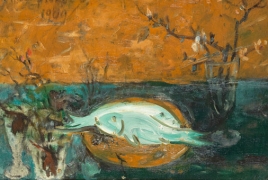
An early work by Mikhail Larionov, a major force in early 20th century Russian art, is to be auctioned at Bonhams. His 1909 work, Still life with fish and flowers, is estimated at £80,000-100,000, and will feature in Bonhams’ Russian sale in London on 8 June, Art Daily said.
Known as the ‘finest Russian impressionist’, Larionov in fact developed past impressionism into an entirely new realm of abstract painting. Still life with fish and flowers defines an important transformative moment in Larionov’s oeuvre and Russian painting as a whole. The work reconciles the influences of European modernism with Russian motifs and painterly traditions.
Daria Chernenko, head of the Russian art department at Bonhams, said, ‘this is a rare and magnificent early Larionov. Paintings of this level and period rarely appear on the market and it will no doubt appeal to both Russian and international collectors, scholars, and cultural institutions.’
Larionov, along with his partner, the celebrated artist Natalia Goncharova, led the charge of the Russian avant garde movement in Russia at the beginning of the 20th century, forming the Jack of Diamondsgroup which exhibited artists such as Wassily Kandinsky, Kazimir Malevich and Aristarkh Lentulov. In 1909, Larionov was greatly influenced by the European avant-garde. Larionov and his contemporaries saw the work of the French cubists and German expressionists all over the Russian press and at the homes of their friend, the renowned collector Sergei Shchukin. Larionov was a well-known eccentric, suspended three times from the Moscow School of Art for his radicalism. He cut a strange figure on the streets of Moscow, shocking the Russian bourgeoisie by walking around in public with hieroglyphs painted all over his face and body. Shortly after this painting was made, Larionov founded the Rayonnist movement. Inspired by elements of Futurism and Cubism, the artist began to tread a third path between Kandinsky’s exploration of abstraction, and Malevich’s constructivism.
But like Malevich, the painting also draws links between the avant-garde and the Russian tradition of iconography. ‘Larionov continuously drew inspiration from Russian Orthodox icon painting and searched for his own concept of ‘the spiritual in art’ as he described it,’ said Chernenko. ‘The fish motif seen in the offered work has its own important course within Larionov’s evolution as an artist.’

